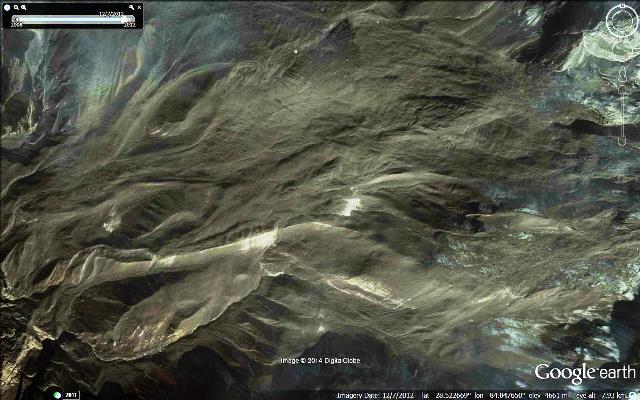1 May 2014
Annapurna plateau: more on the Seti River rock avalanche
Posted by Dave Petley
Annapurna Plateau
Following on from my post yesterday, I have been asked to explain in more detail why I think that the Google Earth imagery indicates that the rock avalanche reached the gorge system on the edge of the Annapurna Plateau. I realise that I was insufficiently clear. In fact the best way to do this is to zoom in to look at the (actually very good quality) imagery in more detail. This is the December 2011 image of the deposit area of the landslide – the source is to the right of the image, the gorge system to the left:
..
And this is the image of the same area from after the landslide:
I hope that these two image make the changes in the landscape on the plateau rather more clear. In the first, the glaciers and glacial sediments have a very complex topography. In the latter image much of this complexity has been removed as the landslide has eroded away the surface. A zoom in to the area close to the edge of the plateau illustrates this more clearly. This is the “before” image:
..
And this is the same area after the landslide:
..
Away from the glaciers, the plateau was clearly covered by a brown layer – I assume that this is thin, scrubby vegetation (though am happy to be corrected). In the lower image this is still present at the very bottom of the shot, which was not affected by the landslide, but it is not present elsewhere, right up to the head of the gully system on the left side. Indeed this change even extends into the gullies. However, there is not much evidence of a landslide deposit anywhere on the image. So to me it is likely that the landslide ran clean across the Annapurna plateau, eroding and entraining ice and sediment en route, and then entered the gullies. This material then made up the bulk of the devastating debris flow that swept down the Seti River valley.






 Dave Petley is the Vice-Chancellor of the University of Hull in the United Kingdom. His blog provides commentary and analysis of landslide events occurring worldwide, including the landslides themselves, latest research, and conferences and meetings.
Dave Petley is the Vice-Chancellor of the University of Hull in the United Kingdom. His blog provides commentary and analysis of landslide events occurring worldwide, including the landslides themselves, latest research, and conferences and meetings.